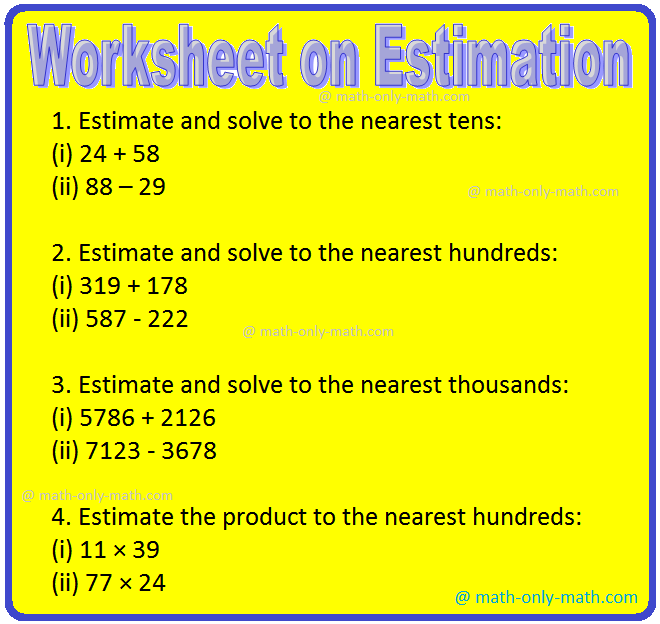Subscribe to our ▶️ YouTube channel 🔴 for the latest videos, updates, and tips.
Worksheet on Estimation
Practice the questions given in the worksheet on estimation. The questions are based on estimating the sum, difference, product and quotient to the nearest tens, hundreds and thousands.
1. Estimate and solve to the nearest tens:
(i) 24 + 58
(ii) 88 – 29
(iii) 95 ÷ 9
(iv) 114 ÷ 14
(v) 4252 ÷ 247
2. Estimate and solve
to the nearest hundreds:
(i) 319 + 178
(ii) 587 – 222
(iii) 623 ÷ 199
(iv) 156 × 450
(v) 146 × 51
3. Estimate and solve to the nearest thousands:
(i) 5786 + 2126
(ii) 7123 – 3678
(iii) 9116 ÷ 2716
(iv) 15214 ÷ 3317
(v) 240265 ÷ 2436
4. Estimate the product to the nearest hundreds:
(i) 11 × 39
(ii) 77 × 24
(iii) 310 × 299
(iv) 516 × 372
(v) 476 × 246
5. Estimate the sum to the nearest hundreds. Verify by actual addition.
(i) 166 + 427
(ii) 6043 + 2476
(iii) 4569 + 3274
(iv) 8042 + 1375
(v) 9563 + 2416
6. Estimate the sum to the nearest tens. Verify by actual addition.
(i) 44 + 27
(ii) 219 + 437
(iii) 572 + 383
(iv) 1076 + 2541
(v) 5431 + 1023
7. Multiple Choice Questions (MCQ)
Choose the correct option.
(i) The number 356842 is rounded to
(a) 356800 to the nearest hundred
(b) 356850 to the nearest hundred
(c) Both (a) and (b)
(d) 356840 to the nearest thousand
(ii) The estimated value of (2588 - 231) is
(a) 2300
(b) 1050
(c) 2450
(d) 2400
8. Match the columns.
|
Column A |
Column B |
|
(a) Estimated value of 87 × 492 to the nearest hundred is _____. |
(i) 1420 |
|
(b) Estimated difference between 64856 and 34200 to the nearest thousand is _____. |
(ii) 11 |
|
(c) Estimated quotient of 5547 ÷ 479 to the nearest hundred is _____. |
(iii) 50,000 |
|
(d) Estimated the sum of 89 and 1334 to the nearest ten is _____. |
(iv) 31,000 |
9. Estimate the following without actual calculation:
(i) 48 × 71
(ii) 2305 - 563
(iii) 77 + 31
(iv) 682 + 20
Answers for the worksheet on estimation are given below to check the exact answers of the above questions.
Answers:
1. (i) 80
(ii) 60
(iii) 10
(iv) 11
(v) 17
2. (i) 500
(ii) 400
(iii) 3
(iv) 100000
(v) 7500
3. (i) 8000
(ii) 3000
(iii) 3
(iv) 5
(v) 99
4. (i) 400
(ii) 1600
(iii) 90000
(iv) 200000
(v) 100000
5.(i) 600
(ii) 8500
(iii) 8000
(iv) 9000
(v) 12000
6. (i) 70
(ii) 660
(iii) 950
(iv) 3620
(v) 6450
7. (i) (a) 356800 to the nearest hundred
(ii) (d) 2400
8. (a) → (iii)
(b) → (iv)
(c) → (ii)
(d) → (i)
9. (i) 3500
(ii) 1700
(iii) 110
(iv) 700
Math Home Work Sheets
From Worksheet on Estimation to HOME PAGE
Didn't find what you were looking for? Or want to know more information about Math Only Math. Use this Google Search to find what you need.



New! Comments
Have your say about what you just read! Leave me a comment in the box below. Ask a Question or Answer a Question.